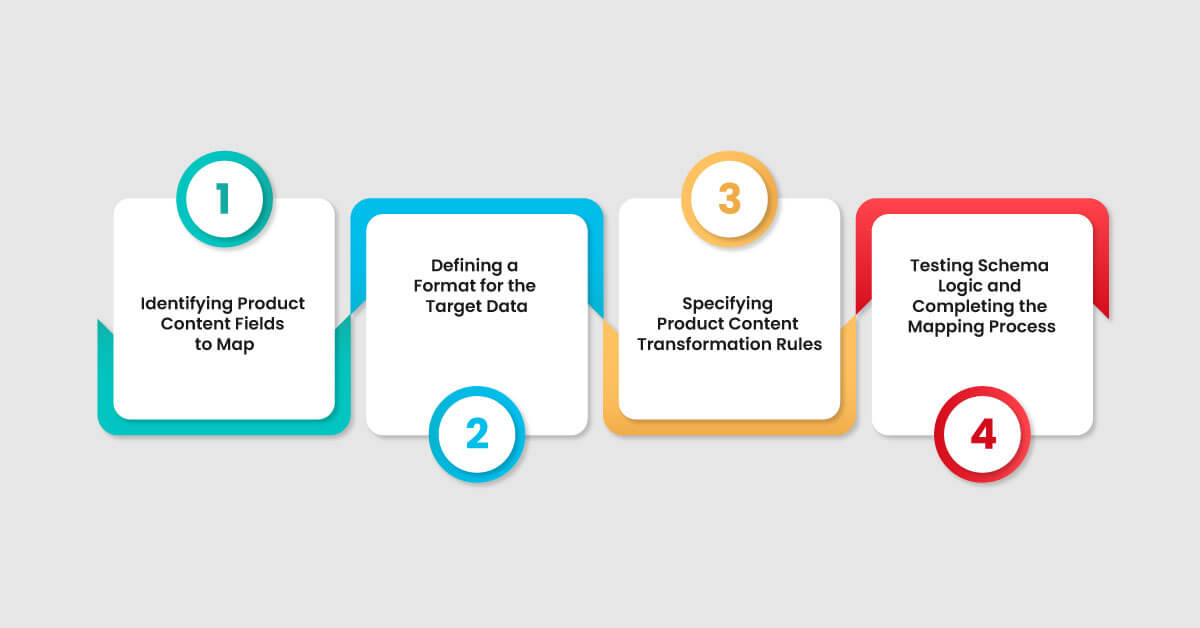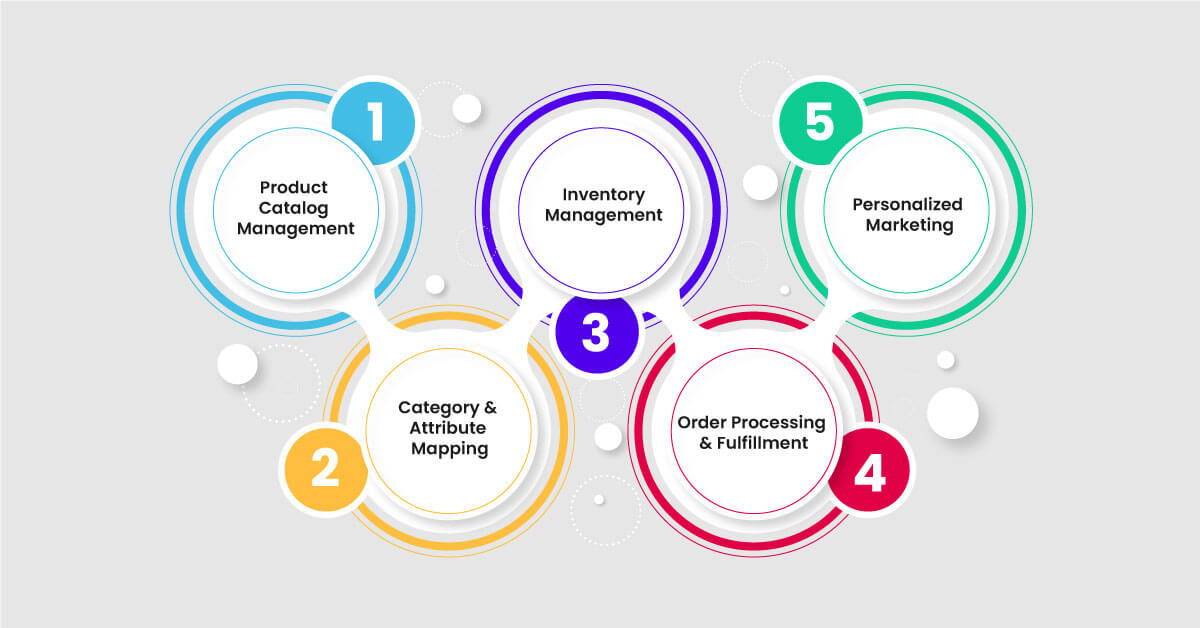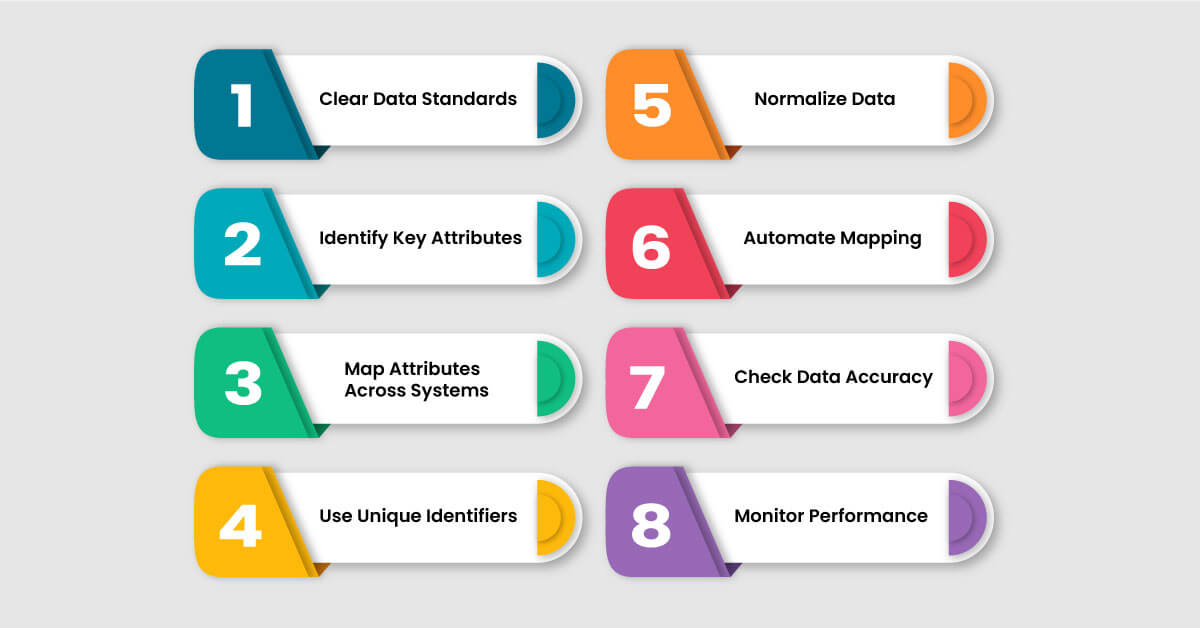
Data mapping is essential for organizing and managing the massive amount of information in eCommerce. In this industry, data comes from many different places and in various forms, so we need a structured way to handle it all.
Think of data mapping as creating a detailed roadmap for all the data. It ensures that every piece of information is accurately recorded, used correctly, and smoothly integrated into our systems. Without this roadmap, managing the constant data flow would be incredibly challenging. With data mapping in place, we can transform and automate processes more efficiently. This allows eCommerce businesses to make better decisions, work more effectively, and provide customers with superior experiences.
What is Product Data Mapping In eCommerce?
The process of organizing and structuring product data mapping in eCommerce refers to the organization and structuring of product information for online sales. In various business applications, the method of mapping information fields extracted from any database or source system to corresponding target fields is referred to by this name. In short, it is a process of identifying data presentation models across various target systems and sources. This contains information about the product, such as its name, description, cost, and other features.
Suppose you run a store with shelves, and every product has a certain spot on the shelves. Determining the appropriate shelf for each product is similar to product data mapping. You make a map or plan that indicates where in the database or system of your online business you should put each piece of product information. When you arrange and standardize this information, it becomes easier for customers to locate what they are searching for when they visit your online business. It also helps in inventory control, sales tracking, and the precise display of product data on various devices.
Product data mapping also helps you keep track of how many products you have and how well they're selling. It ensures that all the product details show up correctly when people visit your site on different devices.
What are the E-commerce Product Data Mapping Techniques?
E-commerce product data mapping techniques are modern ways of organizing and arranging product data in online stores or websites where you can buy things. These methods are crucial because they help make sure that when you're shopping online. It also shows the details about the products correctly and ensures that online stores handle all the data about their sales. Here are some common e-commerce product data mapping techniques:
Manual Data Mapping
Manual data mapping involves a skilled developer using code to link data from different sources together. They build up these associations by correlating the identical data fields from different datasets and constructing the code to say they are correctly integrated.
- In this way, the mapping is done independently, and the result is undisputed. It provides highly adaptive mappings that can be successfully applied in different contexts on the request.
- Manual data mapping is expensive in terms of time and skilled labor. It is primarily code-based, requiring a programmer's competency, making it incomprehensible for those not proficient enough in coding. In addition, manually reporting information to different points of systems can also be time-consuming and stressful.
Semi-Automated Data Mapping
Semi-automated data mapping combines automation with manual intervention. Developers use software tools to identify and match similar data fields, a process often referred to as schema mapping. Then, they use scripts or code to convert the data based on the defined relationships.
- This approach strikes a balance between scalability, efficiency, and flexibility. It streamlines the mapping process by automating specific tasks while allowing for manual adjustments.
- Semi-automated mapping still requires coding knowledge and an understanding of how to navigate between the automated and manual components. Therefore, it can not be as efficient for large-scale projects as fully automated mapping.
Automated Data Mapping
With automated data mapping, users may visually map data fields and transformations, eliminating the need for human coding. These tools frequently provide pre-built transformations and drag-and-drop interfaces, facilitating data manipulation for non-technical users.
- Automated mapping offers faster outcomes and requires minimal coding knowledge, if any. It empowers non-technical team members to manipulate and analyze data without relying on data analysts or developers.
- Some automated tools can be costly and require specific training to use effectively. While automated mapping is efficient for many tasks, it may not offer the same level of customization as manual mapping for complex data integration projects.
What is the E-commerce Product Data Mapping Process?

Product data mapping in eCommerce involves creating a plan for organizing all the information about the products you sell online. Doing this makes it easier for people to find and buy products on your website. The process of mapping product data in e-commerce involves several steps to ensure a smooth data mapping process:
Identifying Product Content Fields to Map
It is crucial to figure out what data needs to be rearranged or moved. This depends on what you're aiming to achieve:
- Integration: Determine how to combine data from different places and how often to do it. Automated tools are best for large data integrations. Manual work is okay for smaller jobs that are just done once.
- Migration: Examine the source data closely and decide what needs to be done at the target destination. Automated software is a good choice if there's a lot of data to transfer.
- Transformation: Decide on the format for processing the data. Automated tools are usually needed, but simple projects can be done manually.
Defining a Format for the Target Data
Establishing a well-defined format and structure for data representation is a critical step in ensuring seamless integration between the source and target databases. It is essential to ensure that the data fields and their respective formats align perfectly across both systems to prevent any ambiguity or misconception. By carefully designing how the data appears in each system, we can guarantee that it is understood correctly and flows between systems without any issues.
Specifying Product Content Transformation Rules
This depends on how you're doing the data mapping. With automated tools, the system handles it without coding. For semi-automatic methods, creating connections using software and having someone manually check them is essential.
Testing Schema Logic and Completing the Mapping Process
If you are using automatic matching, the system will do built-in checks. Otherwise, move a small sample of prepared data and manually check for errors. Testing your logic ensures that the process is completed accurately.
What Are the Use Cases of Product Data Mapping?

This meticulous alignment lays the foundation for a smooth and reliable data flow, enabling efficient communication and synchronization between the source and target databases. Data mapping finds applications in various business scenarios. Here are some common examples:
Product Catalog Management
Online stores get information about their products from different places. Data mapping helps organize this information so that all product details, like names, descriptions, prices, and pictures, are consistent throughout the store. It makes it easier for customers to find what they're looking for because everything looks the same and is easy to understand.
Category and Attribute Mapping
Online stores put products into different groups or categories (like "clothes" or "electronics") to make them easier to find. Data mapping helps make sure each product is put in the right category. It helps customers find products quickly and easily by sorting them into the right sections of the website.
Inventory Management
Stores need to know how much of each product they have in stock. Data mapping helps keep track of this information across different places where they sell things. It helps stores avoid selling products they don't have and make sure they have enough stock to meet customer demand.
Order Processing and Fulfillment
When you buy something online, data mapping helps make sure your order is processed smoothly from start to finish. It ensures that you get what you ordered quickly and without any problems, from paying for your order to getting it delivered to your doorstep.
Personalized Marketing
Stores use information about past purchases and preferences to offer special deals and recommendations. It makes your shopping experience more personalized and enjoyable by showing you things you're interested in and might want to buy.
Best Practices for Product Data Mapping in eCommerce

By following these easy-to-understand tips, you can make sure your product data mapping process is efficient and accurate and helps your e-commerce business succeed. Here are some essential best practices:
Clear Data Standards
Decide on rules for organizing your product data, such as naming conventions and formats. This will make it easier to handle and use your data across different platforms.
Identify Key Attributes
Figure out which details about your products are most important for your business and customers, like the product name, description, price, and size.
Map Attributes Across Systems
Make sure all your product details are mapped consistently across all the platforms you use for selling online. This means each detail should match up correctly in every system you use, like your website and inventory management tools.
Use Unique Identifiers
Use special codes, such as GTINs or UPCs, to ensure each product is identified correctly, and there are no duplicates. These codes help keep your inventory organized and prevent mix-ups.
Normalize Data
Keep all your product data in a standard format so that they look the same everywhere. This means fixing any differences in names, formats, or categories to make it easier for customers to find what they want.
Automate Mapping
Use tools to automate the process of mapping your product data. This will save time, reduce mistakes, and keep your information up-to-date across all your platforms.
Check Data Accuracy
Check your product data regularly to ensure accuracy and up-to-dateness. This will help you avoid mistakes and ensure that your customers are getting the right information.
Monitor Performance
Keep an eye on how well your products are selling and how satisfied your customers are. This helps you see if your data mapping strategy is working effectively and if there are areas where you can improve.
Conclusion
The data mapping process empowers businesses with a real-time, comprehensive view of their product data, enabling them to respond promptly to changes and optimize their marketing strategies accordingly. By integrating eCommerce platforms with Enterprise Content Management (ECM) and Product Information Management (PIM) systems, data mapping facilitates a streamlined approach to collecting, storing, and leveraging product data across multiple systems in an efficient and cost-effective manner. This seamless integration by RetailGators enhances the overall customer experience by ensuring consistent and accurate product information.
Data mapping automates the management and sharing of product information with customers, allowing companies to strengthen customer relationships and expedite supply chain operations. RetailGators can provide customers with up-to-date and accurate product details by eliminating manual processes and enabling real-time data synchronization, fostering trust and loyalty.








Leave a Reply
Your email address will not be published. Required fields are marked